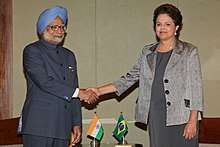Nehru jacket
The Nehru jacket is a hip-length tailored coat for men or women, with a mandarin collar, and with its front modelled on the Indian achkan or sherwani, a garment worn by Jawaharlal Nehru, the Prime Minister of India from 1947 to 1964.

History

The Nehru jacket is a variation of the Jodhpuri where the material is often khadi. The Jodhpuri itself is an evolution from the Angarkha. Popularized during the terms of Jawaharlal Nehru, these distinct Bandhgalas made from khadi remain popular to this day.[1]
Style

Unlike the achkan, which falls somewhere below the knees of the wearer, the Nehru jacket is shorter. Jawaharlal Nehru, notably, never wore a Nehru jacket.[lower-alpha 1][2]
Popularity
The jacket began to be marketed as the Nehru jacket in Europe and America in the mid 1960s. It was briefly popular there in the late 1960s and early 1970s, its popularity spurred by the aspirational class' growing awareness of elite foreign cultures, by the minimalism of the Mod lifestyle and, in particular, by the Beatles and subsequently the Monkees.[3][4][5]
See also
- Nehru vest
- Mao suit
- Mujib Coat
- Gakuran
- Mandarin collar
- Raj pattern
- Abacost
- Kariba suit
- Leisure suit
- Madiba shirt
References
Notes
- "Nehru Jacket, which we know today had undergone alterations from its basic Achkin or Sherwani model over the years even during the lifetime of Nehru. The main difference between the popular Nehru Jacket and the original Achkan is the length. Achkans go below the knees whereas Nehru Jacket hardly reaches hips. It was only after 1940s the term 'Nehru Jacket' was started using widely. Till then it was known as 'band gale Ica coat', which means 'closed neck coat.' The strangest part of the story is that Nehru had never worn the popular, modified ones named after him, but always preferred the traditional models more akin to Ackhan or Sherwani."[2]
Citations
- https://www.outlookindia.com/magazine/story/nehru-jacket-or-modi-vest-which-one-are-you-wearing-today/300859
- Aramam, Ajmal (16 January 2016). "Nehru's style statement: Achkan the knee-length coat made iconic by Nehru is still being worn with pride". Tehelka. Archived from the original on 1 July 2016. Retrieved 26 April 2017.
- http://www.encyclopedia.com/doc/1G2-3425500603.html
- "Nehru jacket – Everything2.com". Everything2.com. 27 July 2001. Retrieved 11 January 2010.
- John Lennon's suit found